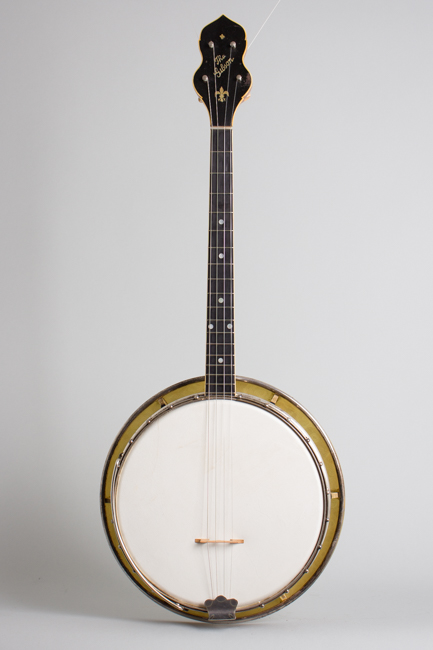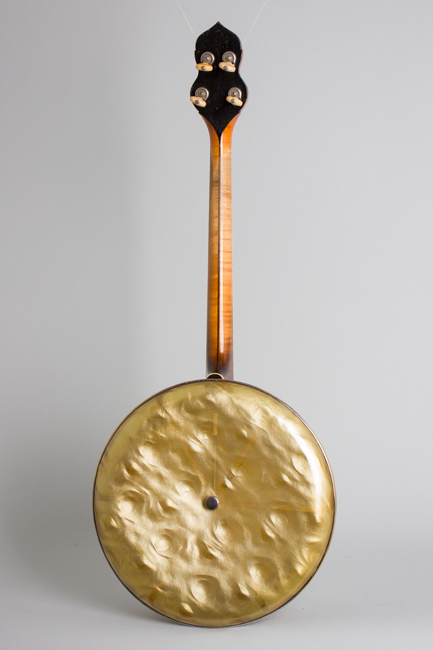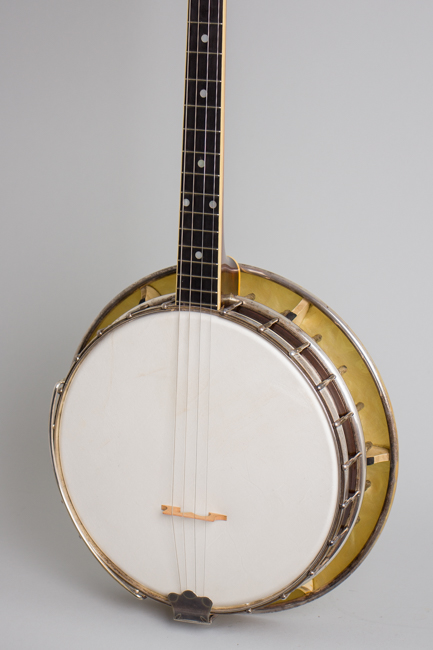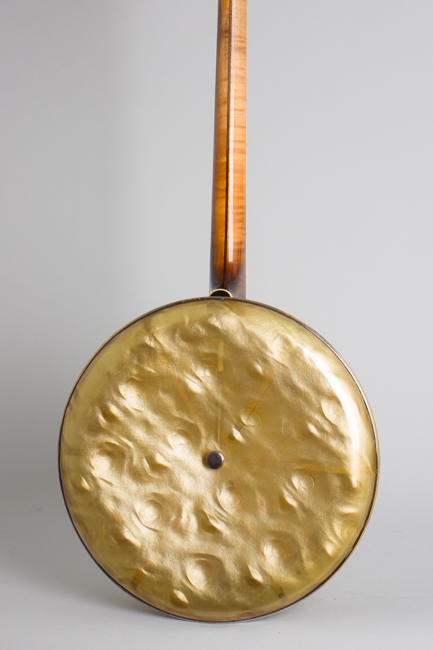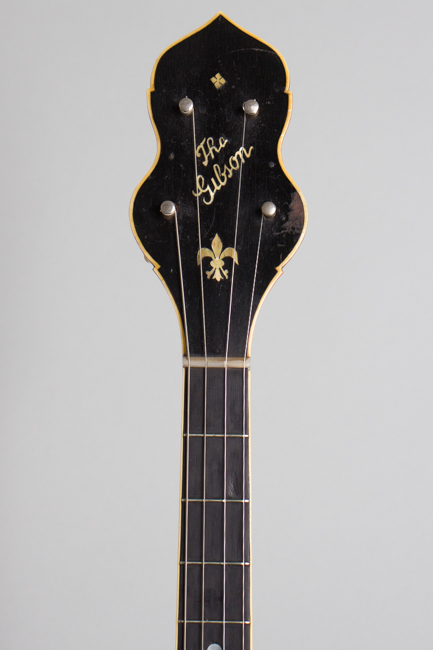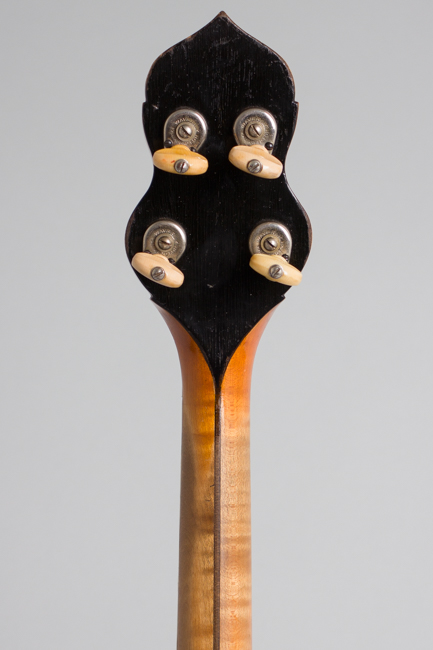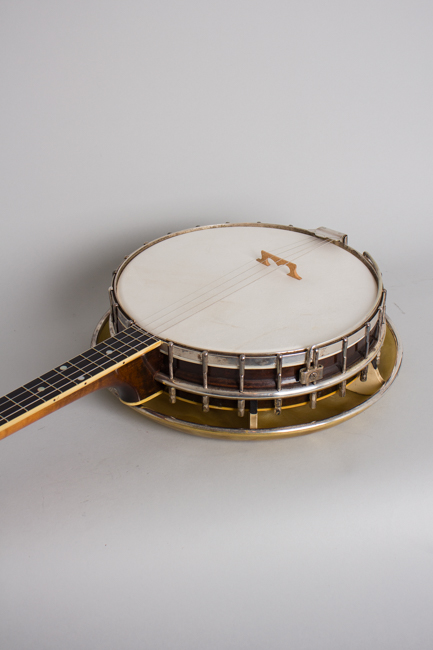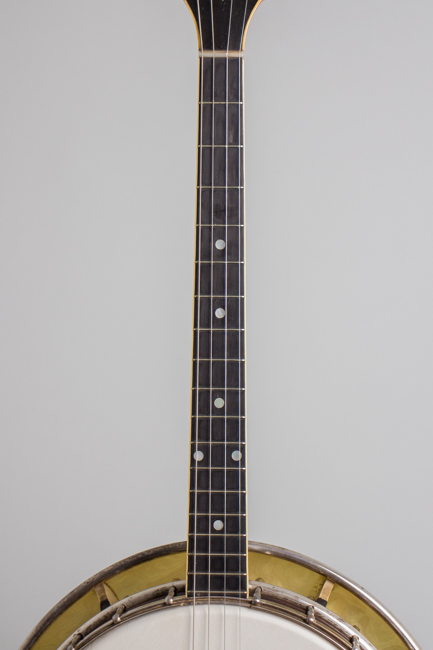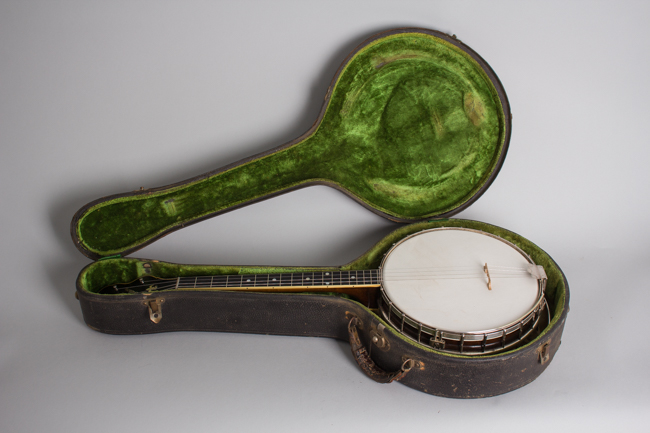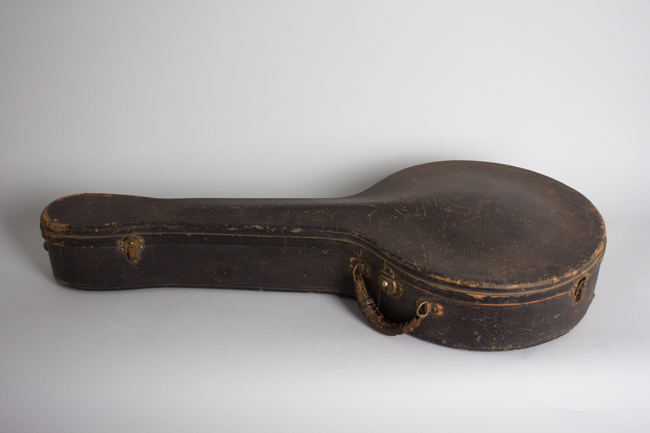Gibson TB-4 Tenor Banjo (1924)
Gibson TB-4 Model Tenor Banjo (1924), made in Kalamazoo, Michigan, serial # 11078A-50, sunburst varnish finish, laminated maple neck and rim, ebony fingerboard, black hard shell case.
Here's a fine "Loar Era" Gibson that won't break the bank! This 1924 TB-4 tenor banjo is a particularly lovely instrument, a rare variation on this model and somewhat eccentric in layout. Although *not* the banjo design that Gibson is best remembered for this TB-4 was built not long before the fully developed Mastertone era with some of the design and construction features that would soon distinguish that line.
With a short 21"scale neck and smaller 10 1/2" diameter rim the early Gibson tenor banjos have the feel of having been designed by and for mandolin players, as indeed they were. While not popular with orchestra tenor banjo players, they sold well for a time to Gibson's mandolin orchestra clientele eager to pick up on new trends. The TB-4 is a beautifully built instrument with an attractive nouveau aesthetic all its own, with a special appeal apart from the rest of the jazz-age 4-string pack.
The laminated maple rim is finished in dark brown, capped with ebony and bound in ivoroid on the lower edge. It carries the Lloyd Loar-designed perforated tubular tone ring resting on ball bearings used for Mastertones through 1927. The tube hook/nut bearing used on this banjo would become half of the "tube and plate" flange system in 1925 when the "plate" flange was added. This banjo features the then-new Gibson dual co-coordinator rod system for adjusting the neck which has since become the world standard. Inside the rim is a gold "Gibson Guarantee" label and impressed factory order number. All hardware is silver plated, the arm reset and engraved tailpiece cover are still intact.
The narrow short scale neck is a 3-way maple/ebony laminate with a dot-inlaid ebony fingerboard bound in grained ivoroid. The single-bound "moccasin" headstock is the unusual larger shape adopted when Gibson began using the earliest Grover geared banjo tuners in place of the mandolin style gears used previously. Only a small proportion of pre-1925 banjos were built with this design, which like its slimmer sibling it is faced with ebony and inlaid with a slanted "The Gibson" logo, slotted diamond and fleur-de-lys in pearl. The heel is a beautiful shaded "Cremona" sunburst with a bound ebony cap and the back of the headstock is black with a point faired into the neck's ebony stripe. The nut is pearl, characteristic of many top-line Gibsons of this era.
The most interesting feature of this TB-4 is the rarely seen cupped Pearl Pyralin resonator that was briefly an upgrade to the older more common trap door. Gibson called it the "Professional Special" resonator and this fitting was only offered in 1924. The pearlescent surface seems to glow with a life of its own and is lovely concept if rather fragile in execution!
This was an expensive ($150) instrument in its day, equivalent to the F-4 mandolin and L-4 guitar and indeed was top of the line until the Style 5 Master Model line was introduced. This later version is a rare and beautiful banjo, and a fine playable piece of 1920's Gibson ephemera, an unequaled bargain for the enthusiast or collector.
Overall length is 31 1/2 in. (80 cm.), 10 1/2 in. (26.7 cm.) diameter head, and 3 3/4 in. (9.5 cm.) in depth, measured at side of rim. Scale length is 21 in. (533 mm.). Width of nut is 1 1/8 in. (29 mm.).
Overall this is a well-preserved banjo, showing some light play wear but all original finish and hardware. The neck finish is rubbed-away down to the wood on both sides in the lower positions. The headstock shows some checking with small chips and flakes, with one rubbed-away spot near the A string tuner. The silver plating is somewhat clouded especially on the nuts. The somewhat fragile Pyralin resonator is in excellent shape with no cracks or damage.
The original frets and the fingerboard have some minor wear but the instrument plays fine, set up with a recent white calfskin skin head and the (very rare) original heart-cutout vintage Gibson bridge. The sound is very different from the standard orchestra tenors of the 1920s, with a rather old-fashioned plunk and more warmth and depth than one might expect from such a small rim. The original green plush-lined shaped case is included, somewhat worn but still fully functional. Overall Excellent - Condition.
Here's a fine "Loar Era" Gibson that won't break the bank! This 1924 TB-4 tenor banjo is a particularly lovely instrument, a rare variation on this model and somewhat eccentric in layout. Although *not* the banjo design that Gibson is best remembered for this TB-4 was built not long before the fully developed Mastertone era with some of the design and construction features that would soon distinguish that line.
With a short 21"scale neck and smaller 10 1/2" diameter rim the early Gibson tenor banjos have the feel of having been designed by and for mandolin players, as indeed they were. While not popular with orchestra tenor banjo players, they sold well for a time to Gibson's mandolin orchestra clientele eager to pick up on new trends. The TB-4 is a beautifully built instrument with an attractive nouveau aesthetic all its own, with a special appeal apart from the rest of the jazz-age 4-string pack.
The laminated maple rim is finished in dark brown, capped with ebony and bound in ivoroid on the lower edge. It carries the Lloyd Loar-designed perforated tubular tone ring resting on ball bearings used for Mastertones through 1927. The tube hook/nut bearing used on this banjo would become half of the "tube and plate" flange system in 1925 when the "plate" flange was added. This banjo features the then-new Gibson dual co-coordinator rod system for adjusting the neck which has since become the world standard. Inside the rim is a gold "Gibson Guarantee" label and impressed factory order number. All hardware is silver plated, the arm reset and engraved tailpiece cover are still intact.
The narrow short scale neck is a 3-way maple/ebony laminate with a dot-inlaid ebony fingerboard bound in grained ivoroid. The single-bound "moccasin" headstock is the unusual larger shape adopted when Gibson began using the earliest Grover geared banjo tuners in place of the mandolin style gears used previously. Only a small proportion of pre-1925 banjos were built with this design, which like its slimmer sibling it is faced with ebony and inlaid with a slanted "The Gibson" logo, slotted diamond and fleur-de-lys in pearl. The heel is a beautiful shaded "Cremona" sunburst with a bound ebony cap and the back of the headstock is black with a point faired into the neck's ebony stripe. The nut is pearl, characteristic of many top-line Gibsons of this era.
The most interesting feature of this TB-4 is the rarely seen cupped Pearl Pyralin resonator that was briefly an upgrade to the older more common trap door. Gibson called it the "Professional Special" resonator and this fitting was only offered in 1924. The pearlescent surface seems to glow with a life of its own and is lovely concept if rather fragile in execution!
This was an expensive ($150) instrument in its day, equivalent to the F-4 mandolin and L-4 guitar and indeed was top of the line until the Style 5 Master Model line was introduced. This later version is a rare and beautiful banjo, and a fine playable piece of 1920's Gibson ephemera, an unequaled bargain for the enthusiast or collector.
Overall length is 31 1/2 in. (80 cm.), 10 1/2 in. (26.7 cm.) diameter head, and 3 3/4 in. (9.5 cm.) in depth, measured at side of rim. Scale length is 21 in. (533 mm.). Width of nut is 1 1/8 in. (29 mm.).
Overall this is a well-preserved banjo, showing some light play wear but all original finish and hardware. The neck finish is rubbed-away down to the wood on both sides in the lower positions. The headstock shows some checking with small chips and flakes, with one rubbed-away spot near the A string tuner. The silver plating is somewhat clouded especially on the nuts. The somewhat fragile Pyralin resonator is in excellent shape with no cracks or damage.
The original frets and the fingerboard have some minor wear but the instrument plays fine, set up with a recent white calfskin skin head and the (very rare) original heart-cutout vintage Gibson bridge. The sound is very different from the standard orchestra tenors of the 1920s, with a rather old-fashioned plunk and more warmth and depth than one might expect from such a small rim. The original green plush-lined shaped case is included, somewhat worn but still fully functional. Overall Excellent - Condition.
